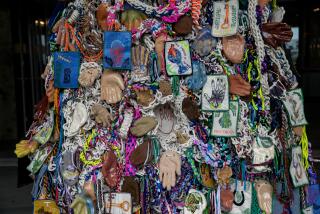Artist Carves Out Niche With a Chain Saw
- Share via
LUNENBURG, Vt. — It’s loud, it’s dirty, it’s dangerous.
And although it demands control, precision and considerable skill, the art of chain-saw carving apparently isn’t highbrow enough to garner respect from the mainstream arts and crafts community.
Chain-saw carvers use their noisy, unwieldy tools to turn logs into bears, benches, eagles and just about everything in between. It helps to be strong enough to control the chain saw without severing a limb in the process.
“You’ve got to be mechanically inclined to do this,” said Mark Fontaine, who sells bears and other pieces from his home in Vermont’s northeastern corner. “You’ve got to run power tools without hurting yourself.”
Chain-saw art is popular all over North America, especially in areas like Vermont with a longtime tradition of logging.
Fontaine, who comes from a long line of loggers in Groveton, N.H., never wanted to go into logging. “I knew I was going to make my living off my artwork,” he said. “I just wasn’t sure how.”
Before he started making a living from his art, Fontaine, 34, worked in construction, drove trucks in Alaska, was a laborer on the local railroad and was part of a dynamite crew. He started carving wood with a knife “as soon as I was old enough to cut myself,” but it was only in 2001 that he picked up a chain saw and tackled a big piece of white pine.
He was hooked.
The chain saw is fast, and it takes a special skill to turn out pieces that look like art. The archetypal chain-saw creation, the bear, often comes out looking crude and roughhewn.
But Fontaine’s bears, which make up 90% of his orders and cost from $50 to $550 and more, are handsome to look at, the result of delicate handling. They are stained with porch stain and linseed oil, and they have black hematite stones for eyes.
“I take pride in my bears,” he said, although he refuses to say how long it takes him to carve one. “I’m not trying to do production. It’s an original piece of artwork. Some people want a special piece of Vermont they can bring home with them.”
Fontaine also does eagles, benches and trees, and he has carved on commission such diverse items as newel posts, a Mack truck, rainbow trout and a caricature moose, to name a few.
He recently delivered an 8-foot-tall beaver to a store in Lancaster, N.H. He’s done several dragons, and he was recently commissioned to do a gargoyle.
What carvers create depends somewhat on where they live. Chain-saw artist Burt Fleming of Baker, La., carves a lot of alligators and pelicans and is hard at work on a huge crucifix, complete with a 10-foot-tall Jesus. But like Fontaine, most of Fleming’s business is in bears. He thinks that’s because bears can stand up on their hind legs.
“They can hold signs, they can wave at you; they might hold a pot or a mailbox,” Fleming said. “A duck or something like that ... he’s either standing or sitting or flying. Any time you make a bird hold something, it’s not normal.”
Fontaine has nine chain saws of different sizes with different blades -- one painted the colors of the American flag. He wears shorts, sandals, ear and eye protection, and thick gloves. He uses Vermont pine, and he signs and dates every piece he makes.
He has never been to a craft show and doesn’t plan to go. He lines up his wares on the front lawn of the home he shares with his 6-year-old son -- the place where the carving is done -- and waits for passersby to stop in.
“I don’t need to go anywhere. I can stay right here,” he said.
But this is an art that wins little respect.
Although there were metal artists and woodworkers among the potters, glassblowers, weavers and painters on the recent Open Studio Tour organized by the Vermont Crafts Council, chain-saw artists were absent.
But Martha Fitch, council executive director, said chain-saw art shouldn’t be treated any differently from other sculpture.
“The whole art of sculpture is seeing the form inside the material and cutting away the part that doesn’t belong,” she said. “People using chain saws to do that are doing the same thing as people using tools to cut away a part of granite.
“Underlying some of the interest is that it’s scary,” Fitch said.
Fontaine isn’t concerned about the mainstream art community’s opinion. He’s always known that chain-saw artistry wasn’t a highbrow undertaking:
“We’re not really considered real artists because we use a chain saw. We’re the hillbillies of the artist feeding chain. The people that do buy my product, their appreciation is enough for me.”
More to Read
The biggest entertainment stories
Get our big stories about Hollywood, film, television, music, arts, culture and more right in your inbox as soon as they publish.
You may occasionally receive promotional content from the Los Angeles Times.










